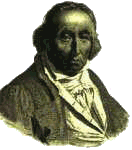
Joseph-Marie Jacquard

1752-1834
Jacquard was born to a poor silk merchant in Lyon, France in
1752. When his father died in 1772 he inherited a the family house and a hand
loom with which he ran a silk factory until his penchant for trying to improve
the process doomed the business. Jacquard apparently had developed the
basic idea of the loom by 1790. However, he served in the army during the
French revolution during which time he made no progress. Finally, in 1801 Jacquard exhibited a loom for weaving figured
silk in Lyons. In the ensuing mayhem the inventor was attacked and his
invention reduced to ruins. According to Jacquard's account, "The iron was sold for old iron, the wood for kindling, while I was delivered over to universal
ignominy." In 1803 demonstrated the machine in Paris, where he was
awarded a patent and a medal. In 1806 the loom was declared public property, and Jacquard was given a pension and a royalty payment for each machine.
It is estimated that by 1812 there were 11,000 in use in France. Jacquard
was able to lead a quiet and comfortable life until his death in 1834, at Oullins, near Lyon.
Jacquard's primary contribution to weaving and to automation in general was the
introduction of punch cards that automated the very tedious and labor intensive
process of weaving patterns into a fabric. The punch cards encoded
information in a way which could then guide the machine in ways that previously
required humans. In addition to Babbage, the American statistician Herman Hollerith
employed punch cards as a form of data entry for the 1890 census. Punch cards were once the usual means of feeding programming and data into a computer.
|
Loom Held at Smithsonian Museum |
Another Jaquard Loom |

A Puchcard for the Loom |
|
Links